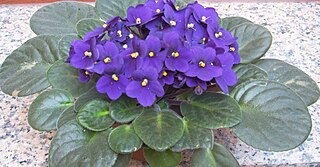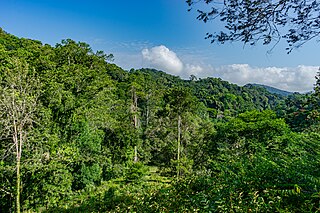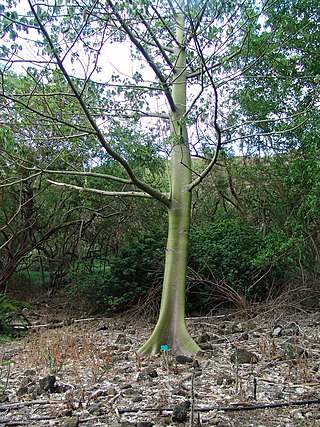Erythrococca is a plant genus of the family Euphorbiaceae, first described in 1849. It is native to Africa and the Arabian Peninsula.

Ricinodendron is a plant genus in the family Euphorbiaceae first described as a genus in 1864. It includes only one known species, Ricinodendron heudelotii, native to tropical Africa from Senegal + Liberia east to Sudan and Tanzania and south to Mozambique and Angola. It produces an economically important oilseed. The tree is known as munguella (Angola), njangsa (Cameroon), bofeko (Zaire), wama (Ghana), okhuen (Nigeria), kishongo (Uganda), akpi, djansang, essang, ezezang and njasang. Two varieties of the tree species are recognized R. heudelotii var. heudelotii in Ghana and R. heudelotii var. africanum in Nigeria and westwards.

Streptocarpus sect. Saintpaulia is a section within Streptocarpus subgenus Streptocarpella consisting of about ten species of herbaceous perennial flowering plants in the family Gesneriaceae, native to Tanzania and adjacent southeastern Kenya in eastern tropical Africa. The section was previously treated as a separate genus, Saintpaulia, but molecular phylogenetic studies showed that it was nested within the genus Streptocarpus.

Gomortega keule is a tree native to Chile. It is the sole species of the genus Gomortega and, according to the APG IV system of 2016, of the monotypic family Gomortegaceae, assigned to the order Laurales in the clade magnoliids.

The Amani Forest Reserve, officially listed as Amani Nature Forest Reserve is a protected area located the Muheza and Korogwe Districts in the Tanga Region of Tanzania. The nature reserve was established in 1997 in order to preserve the unique flora and fauna of the East Usambara Mountains. The East and West Usambara Mountains are a biodiversity hotspot. The Amani Nature Reserve includes tropical cloud forest habitats.

Rhodognaphalon mossambicense, the East African bombax or wild kapok tree, is a species of flowering plant in the family Malvaceae. It occurs from southeastern Kenya through the coastal and Eastern Arc forests of Tanzania to northern Mozambique and Malawi.
Allanblackia gabonensis is a species of flowering plant in the family Clusiaceae. It is found in Cameroon and Gabon. Its natural habitat is subtropical or tropical moist lowland forest. It is threatened by habitat loss.

Allanblackia is a genus of flowering plant in the family Clusiaceae. Molecular phylogenetic analyses indicate that is it nested in the dioecious Garcinia. The genus name commemorates Allan Black.

Allanblackia stuhlmannii is a species of flowering plant in the family Clusiaceae. It is found only in Tanzania.
Mammea usambarensis is a species of flowering plant in the Calophyllaceae family. It is found only in Tanzania.
Vismia pauciflora is a species of flowering plant in the Hypericaceae family. It is found only in Tanzania. It is threatened by habitat loss.
Alsodeiopsis schumannii is a species of plant in the Icacinaceae family. It is endemic to Tanzania, specifically the East Usambara, the Uluguru Mountains, and the Southern Highlands.
Neocussonia lukwangulensis is a species of plant in the family Araliaceae. It is endemic to the Eastern Arc Mountains of Tanzania. It is typically a freestanding tree, and uncommonly an epiphyte.
Warburgia ugandensis, also known as Ugandan greenheart or simply greenheart tree, is a species of evergreen tree native to East Africa. Countries in which the plant species is found include Kenya, Tanzania and Uganda. The wood is resistant to insect attack and very strong. It was commonly used for the yoke pole of ox-wagons, the Disselboom. Early Indian immigrants to Kenya, working on the construction of the railway, used the leaves to flavor their curries before the chilli plant was commonly introduced. The flavor is hot and subtly different from chillies.
Allanblackia oil is a vegetable oil that comes from the seeds of trees of the genus Allanblackia. This tree can be found in the wet tropical belt of Africa. Because of its unique blend of fatty acids, the oil from Allanblackia seeds has melting properties that make it excellent to use as structuring fat in food products, e.g. margarines.
Scheffler's dwarf gecko is a species of lizard in the family Gekkonidae. The species is native to East Africa. There are three recognized subspecies.
Aningeria adolfi-friederici is a species of plant in the family Sapotaceae, a tall, tropical forest tree. It is found in Burundi, the Democratic Republic of the Congo, Ethiopia, Kenya, Malawi, Rwanda, Sudan, Tanzania, Uganda, Zambia and Zimbabwe. The specific name adolfi-friedericii was given in honour of Duke Adolf Friedrich of Mecklenburg, a German explorer in Africa. Its trade name muna is taken from Gĩkũyũ mũna.

Phyllogeiton discolor, known as bird plum or brown ivory in English, is a tree native to southern and eastern Africa including Madagascar. It is a broadleaf tree growing to 18 m (60 ft).
Streptocarpus ulugurensis is a species of flowering plant in the family Gesneriaceae. It is an herbaceous perennial endemic to the Uluguru Mountains of Tanzania.







